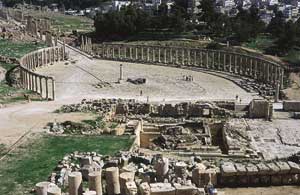Jerash, Jordan
Jerash (ancient Gerasa) is the capital of Jerash
Governorate part of the Kingdom of Jordan. The total population
of the city of Jerash and nearby villages exceeds 120,000
people.
Jerash is situated in the north of Jordan in the
ancient region of Gilead, 45km north of the capital Amman.
Jerash Governorate's geographical features varies from cold
mountains to fertile valleys from (300 to 1100 Meters above
the sea level), suitable for growing a wide variety of agricultural
crops.
Ancient Jerash
 |
| The oval
Forum of Roman Jerash,
and the South end of the Cardo |
Jerash, known in ancient times as Gerasa, is considered
one of the most important and best preserved Roman cities
in the Near East. It was a city of the Decapolis.
Recent excavations show that Jerash was inhabited
during the Bronze Age and Iron Age (3200 BC - 1200 BC. Jerash
was a part of the Kingdom of Israel. After the Roman conquest
in 63 BC, Jerash and the land surrounding it were annexed
by the Roman province of Syria, and later joined the Decapolis
cities. In AD 90, Jerash was absorbed into the Roman province
of Arabia, which included the city of Philadelphia (modern
day Amman). The Romans ensured security and peace in this
area which enabled its people to devote their efforts and
time to economic development and building activity.
In the second half of the first century AD, the city
of Jerash achieved great prosperity. In AD 106, the Emperor
Trajan constructed roads throughout the provinces and more
trade came to Jerash. The Emperor Hadrian visited Jerash in
AD 129-130. A remarkable Latin inscription records a religious
dedication set up by members of the imperial mounted bodyguard
"wintering" there. The Triumphal Arch (or Arch of Hadrian)
was built to celebrate his visit.
 |
Map of the Decapolis
showing location of Gerasa (Jerash) |
The city finally reached a size of about 800,000
square metres within its walls. The Persian invasion in AD
614 caused the rapid decline of Jerash. However, the city
continued to flourish during the Umayyad Period, as shown
by recent excavations. In AD 746, a major earthquake destroyed
much of Jerash and its surroundings. During the period of
the Crusades, some of the monuments were converted to fortresses
including the Temple of Artemis. Small settlements continued
in Jerash during the Ayyubid, Mameluk and Ottoman periods,
and in 1878, Circassians settled in the town after immigrating
from their homeland in the Caucausus. Excavation and restoration
of Jerash has been almost continuous since the 1920s.
There are a large number of striking monuments located
in Jerash: the Corinthium column, Hadrian's Arch, a circus/hippodrome,
two immense temples (to Zeus and Artemis), the nearly unique
oval Forum which is surrounded by a fine colonnade, a long
colonnaded street or cardo, two theatres (the Large South
Theatre and smaller North Theatre), two baths, a scatter of
small temples and an almost complete circuit of city walls.
Most of these monuments were built by donations of the city's
wealthy citizens. From AD 350, a large Christian community
lived in Jerash, and between AD 400-600, more than thirteen
churches were built, many with superb mosaic floors. A cathedral
was built in the fourth century A.D. An ancient synagogue
with detailed mosaics, including the story of Noah, was found
beneath a church.
Today the ruins of Jerash are thoroughly excavated
and excellently preserved. This has led to a nickname, the
"Asian Pompeii."
Modern Jerash
Jerash was a small village attached to town of Souf
( Center of al-Meradh area during the Ottoman Empire ). It
was re-inhabited during the second half of the nineteenth
century by the local people of souf and the surrounding villages.
During that Jerash was a target for successive migrants waves
include Syrians (Shwam), the Circassians and in at the second
half of twenteeth century by the Palestinian Refugees.
Jerash has developed dramatically in the last 50
years, This is due to its strategic location in the heart
of Jordan and because of the growing importance of the tourism
industry to the city. Jerash is now the second-most popular
tourist attraction in Jordan, closely behind the splendid
ruins of Petra. The ruins have been carefully preserved and
spared from encroachment, with the modern city sprawling to
the west of ancient Jerash's city walls.
For the last 26 years, the city has hosted the famous
Jerash Festival [1], a three week long summer programme of
dance, musical, and theatrical performances. The festival
is frequently attended by members of the royal family of Jordan,
and is hailed as one of the largest cultural activities in
the region. Some of the Jerash Festival events, especially
the poetic conferences, are held in the capital city of Amman.
However, the festivities have been suspended for the 2006
season due to regional instability.